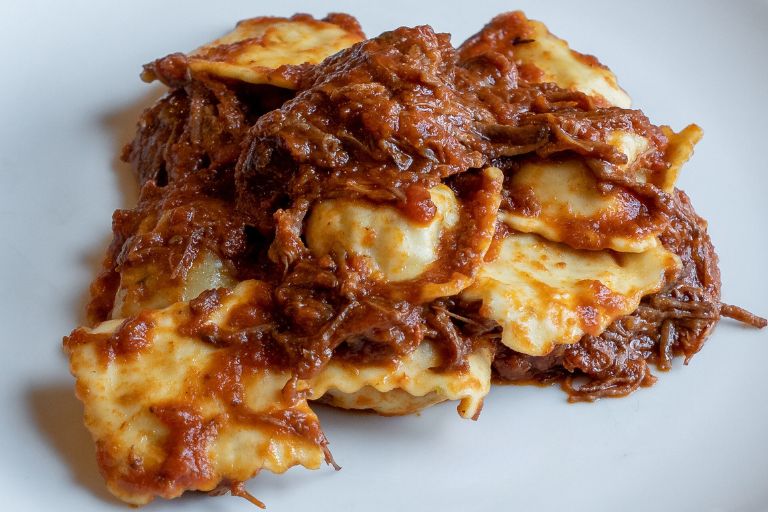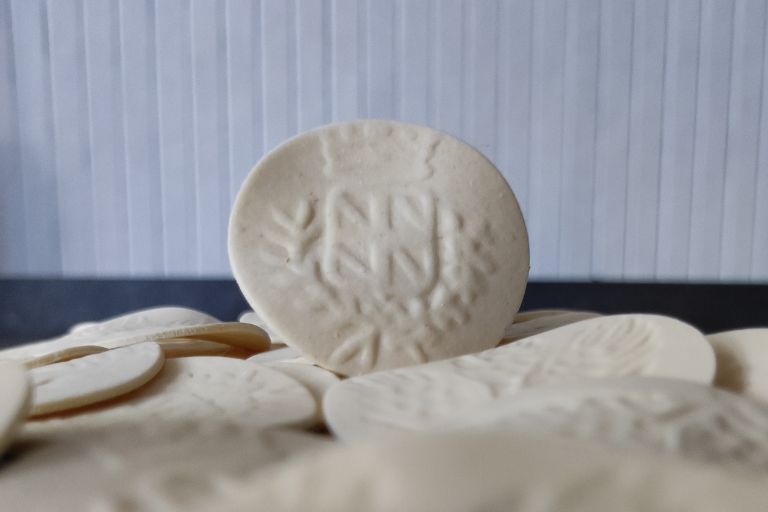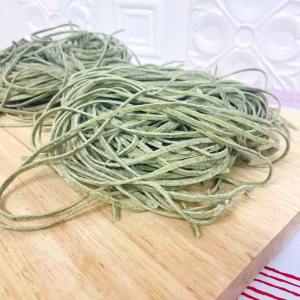
Ligurian pasta dishes are the most abundant part of the local menu. It must be because of the great tradition of Genoese pasta. It is not for nothing that Liguria is home to one of the most famous and eaten sauces and condiments: pesto genovese. And on this page you will learn more about how to use it in first courses and what other dishes you absolutely must try!
THE MOST FAMOUS PASTA DISHES
Strictly in random order. The gastronomic traditions of Liguria, although they have many points in common from Ponente to Levante, vary a little and there will be dishes that are more famous in one place than another. But let's start immediately with what is certainly the most famous...
Pasta al pesto
Trofie, gnocchi, trenette, lasagne... you name it, in Genoa and Liguria, pesto is the main condiment for pasta and is combined with both fresh (not filled) and dry pasta, short and long pasta.

Pansotti (or pansoti) with walnut sauce
Tortelloni originating in the Golfo Paradiso (between Genoa and the Portofino Promontory) have a filling of herbs and cheese. They are traditionally dressed with a sauce made of walnuts, bread soaked in milk, garlic and marjoram. If you are interested in finding out more about this stuffed pasta, I have written a guide on what pansotti are.
Genoese Minestrone
The unique texture of Genoese minestrone is a source of pride for many cooks. When cooked, it should be firm to the point that when you put the spoon into the dish, the spoon should stand upright. It is eaten lukewarm if not almost cold. Pesto is added when serving. Below is our recipe.
Ravioli with tuccu (meat sauce)
The Genoese ravioli par excellence are those with a mixed filling of borage and meat. The pasta is made with a few eggs. Tuccu sauce, on the other hand, is a red sauce of tomato and meat. Its particularity is that the meat used is a whole piece that is cooked for a long time. It is therefore not the usual meat sauce.

Ravioli with mushroom sauce
Mushrooms are omnipresent in Ligurian recipes, because a bit of dried mushrooms to give flavour is not denied to anyone. But they also have their own sauce! A tomato sauce with which to season borage ravioli, fresh taglierini or corzetti della Val Polcevera (not to be confused with croxetti).
Christmas Macaroni in broth
As the name implies, this is a typical Christmas pasta dish. They are very long macaroni that may resemble Neapolitan ziti. They are cooked in capon broth and served with sausage balls.
Croxetti with pinut sauce
They are famous for being small moulded discs with a relief on both sides. They originate from the Val di Vara and the Levante area. In addition to pesto, they are dressed with a very delicate pine-nut sauce (similar to walnut sauce).

GENOESE PESTO
When talking about pasta dishes in Liguria, one immediately thinks of pesto. Although pesto genovese is a cold sauce, which is therefore also good spread on bread, it is first and foremost a condiment for pasta. The very historical evolution of the recipe is linked with its use as a sauce. Pesto started out as a chop of herbs, garlic and cacio cheese and then established itself with its seven definitive ingredients: Genovese PDO basil, grana or parmesan cheese, pecorino, garlic, pine nuts, EVO oil and salt.
Genovese pesto should be added to pasta at the moment of seasoning the dish. It should not be heated or stir-fried. It should be diluted to taste with a little cooking water from the pasta to dissolve it and make it creamier. Especially with trofie and trenette, pesto pasta is served with green beans and potatoes, which are cooked with the pasta. Pesto goes well with any format and type (we only recommend against stuffed pasta, there are more suitable sauces such as tuccu or walnut sauce).
If you want to learn more about how to use pesto, other than with pasta, read this guide on how to use ready-made pesto.
If you want to try our pesto modo21, a true Genoese pesto made with only 7 ingredients, you can buy it on our website.
THE LIGURIAN PASTA TRADITION
Everyone knows the great Neapolitan tradition, that of Gragnano, or the Emilian tradition of fresh pasta, but few know that Liguria, and Genoa in particular, has been one of the historical leaders of Italian pasta. This importance is immediately obvious from the large number of typical Ligurian pasta types.
Trofie
Or trofiette, as people prefer to call them, are a type of short pasta with the twisted shape of a wood chip. They originate from the area of the Riviera di Levante, just outside Genoa. They are traditionally seasoned with pesto and thanks to their versatility are also used with a variety of sauces (e.g. fish sauces) and can also be used for baked pasta.
Trenette
Long dry pasta that is seasoned with pesto, potatoes and green beans. Ligurian trenette are 'relatives' of linguine, so they have an ovoid shape (they are like spaghetti but bulky). As well as with pesto, they are excellent to be sautéed in a frying pan with whatever sauce you prefer.
Taglierini
In dialect 'taggiaen'. They are usually fresh. In appearance they do not differ from tagliolini. They can be white or green, when borage is added to the mixture. They can be dressed with meat tuccu, with earthy sauces (mushroom sauce) or with fish sauces, e.g. a red sauce with seafood or a white one with prawns and marjoram.
Lasagna
Lasagne in the oven is the only exception as far as cooking with pesto is concerned. In Genoa, lasagne is also eaten simply dressed with pesto, without baking. It is a lasagne with a very thin, almost transparent sheet, and in dialect we call it 'mandilli de sea' (silk handkerchiefs).
Potato gnocchi
Yes, OK, gnocchi are part of any world gastronomic culture but here in Genoa there is a real veneration. Why? Guess what... because they are eaten with pesto! And with pesto they are really, really extraordinary. A little curiosity, in Genoese, potato gnocchi are called 'troffie'.
Ravioli
Borage and meat ravioli and pansoti di magro (stuffed with herbs and cheese) are certainly the most eaten. Pansoti can be made in different shapes: triangular, crescent-shaped but we prefer the pot-bellied ones. Fish ravioli (zembi d'arzillo in dialect) are another type of typical Ligurian filled pasta.
Learn more
If you want to learn more about fresh Ligurian pasta, we have a guide on the subject: how to season it, how long to cook it and how much pasta per person.
THE RECIPE OF GENOESE MINESTRONE
Vegetable minestrone made in Genoa is also ultimately a pasta dish, because pasta is almost always used in the recipe. Seasonal vegetables should preferably be used, so the list of ingredients may vary depending on the time of year. What makes minestrone genovese unique compared to other minestrone is its consistency, which must be very thick and creamy. It is not pureed, but the vegetables must flake due to the long cooking time. Some crush some of the vegetables a little while they cook so as to increase the density of the minestrone. Pesto is added at the end, at the moment of serving. It is eaten lukewarm and indeed some prefer it cold.
Ingredients for 4 servings
- 300 g soup pasta
- 2 courgettes
- 1 aubergine
- 1 carot
- 1 celery stalk
- 1 onion
- 1 potato
- 100 g fresh borlotti beans
- 100 g cabbage
- 100 g chard
- 100 gr green beans
- 150 g genoese pesto modo21
The recipe
No sautéing. Vegetables should be cut into cubes or into strips in the case of cabbage. If dried beans are used, they should be left overnight in water and then blanched separately for an hour.
Take a pot with one and a half litres of water. Add the cabbage and aubergines, season with salt and put on the heat. When the water boils, add the other vegetables. The water should remain flush. Some people also put in a piece of parmesan rind: it will not melt completely but will give the soup more flavour. Let it cook for at least two hours over a gentle heat. At this point the vegetables should fall apart as you turn them in the pot. Adjust the salt. Add the pasta and a little water (with experience you'll see if you need to add it or if it's OK). Cook the pasta, turn off the heat and leave to cool. Add the pesto and then when it is at the desired temperature serve at the table!
















